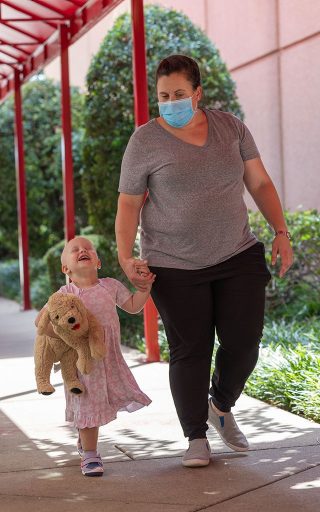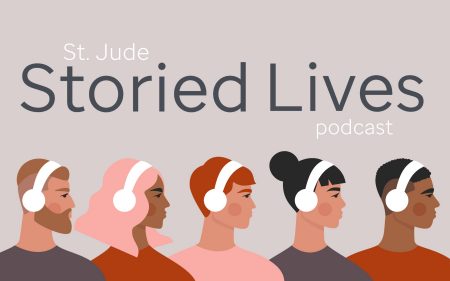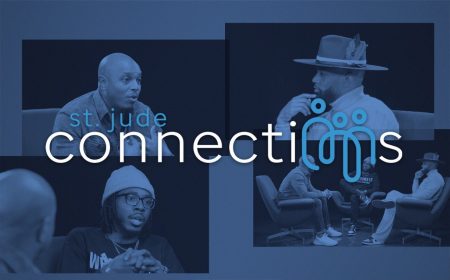
Natalie got a second chance – and then a third – at St. Jude
Cancer puts life on pause. Natalie’s family chose to make the most of every day.

November 29, 2023 • 3 min

Nicole was packing for her family’s move to their new house on a Friday when she noticed her youngest, Natalie, just 16 months old, suddenly stopped using her left arm.
Maybe she’d injured it playing. She’d been playing in the snow with her four brothers and sisters.
With Natalie holding a banana in her right hand, Nicole handed her a lavender hair bow to hold in her left, and asked, “Can you put your arm way up high?”
Natalie lifted the bow but only bent her arm at the elbow.
“Show me way up high!” Nicole said. Natalie shook her head. No.
“Can you hold your banana way up high?” Nicole asked. Natalie raised the banana over her head.
“Good job!” Nicole said. “Can you hold your bow way up high?”
Natalie lifted the bow, again only bending her arm at the elbow.
Her dad, Andrew, a chiropractor, agreed something was wrong. Nicole’s sister, a physical therapist, recommended a pediatric orthopedist.
On Monday, while waiting for a call back for an appointment, Natalie tumbled from a kitchen chair, landing on her left arm.
Nicole scooped her up, dropped the other kids with grandparents, and rushed to the pediatric emergency room an hour away.
An X-ray of Natalie’s left arm showed a fracture — and something more.
A ‘nightmare’ diagnosis
Natalie’s humerus, the bone between her shoulder and elbow, looked more like a sea sponge than a bone. It could be cancer, the doctor said, admitting Natalie overnight.
An MRI the next day showed a softball-sized mass in Natalie’s belly. Reeling, Nicole and Andrew took Natalie home to await biopsy results.
“We felt like we were living in a nightmare,” Nicole said. “It was like the world was spinning by us, and we were frozen in time.”
Time doesn’t stop, not even for cancer.
That Saturday, family, friends and even strangers arrived at their house with trucks pulling trailers, surprising the family, to move them to their new house.
The call with Natalie’s results came an agonizing few days later.
Natalie had a rare high-risk form of neuroblastoma, a pediatric cancer that develops in neuroblasts, cells which develop into nerve cells — and it was spreading fast. Five-year survival rates for Natalie’s neuroblastoma had been at around 50 percent for a decade.
To Nicole and Andrew, the treatment, which could stretch over years, sounded tortuous. High-dose chemotherapy, radiation therapy, surgery and bone marrow transplants — and even that might not be enough to wipe it out.
Could they put Natalie through it?
“Are we going to do all this and flip a coin as to whether she lives?” Nicole said. The family prayed about it. “From a faith standpoint, in heaven, her chances of being healed would be 100 percent,” Nicole said.
The family would squeeze in as many memories as they could in whatever time they got with Natalie.
But Nicole couldn’t help imagining all the moments Natalie wouldn’t get. Her first trip to the beach. A second birthday party. The first day of school.
‘I was at peace with it’
Nicole and Andrew held hands on the hour-long drive to tell the oncologist they had chosen palliative care for Natalie.
“As terrible as it would be for us, I was at peace with it,” Nicole said. The family would be together again in heaven.
But before they got a chance to tell the oncologist, she told them Natalie had been accepted at St. Jude Children’s Research Hospital, where doctors were using a promising therapy that had, in a clinical trial, increased three-year overall survival rates for patients with neuroblastoma like Natalie’s to 86 percent.
“It was as if God had flung open a door,” Nicole said. They would go through it.
Ten days after moving into their new house, Nicole, Andrew and Natalie left it, making the 725-mile drive to St. Jude on Feb. 15, 2022. Likely only Andrew would be back for some time. Natalie might never come home.

Finding hope
At St. Jude, Andrew and Nicole met with Sara Federico, M.D., a pediatric oncologist and clinical researcher, who explained that Natalie’s treatment would take 15 to 18 months and would include chemotherapy, surgery, bone marrow transplants, radiation therapy and antibody treatment that specifically targets the cancer cells and then signals the patient’s immune system to fight any leftover tumor cells.
“We thought we were losing our daughter and when we came to St. Jude, everything changed,” Nicole said. “At St. Jude, there was hope.”
Nicole felt Natalie’s treatment was working before scans showed it. After six weeks of treatment, Natalie was using her left arm again.
In a video Nicole shot on March 31, 2022, to send to Andrew, she asked Natalie, “Can you put your hands up in the sky?” Natalie raised her right arm.
“Can you do your other hand?” Nicole asked. “Both of them?”
Natalie raised her right arm — and then her left, wiggling her fingers in a wave.
Chemotherapy shrank the tumor in Natalie’s belly to the size of a grape. Surgery to remove it left a tiny scar. Five months after her diagnosis, Natalie’s humerus looked like bone again — and scans showed no evidence of disease.
Natalie’s treatment continued with two bone marrow transplants, one in July 2022, the second in September 2022.
Finally, on Dec. 17, 2022, after 10 months at St. Jude, Natalie and Nicole got to go home, just in time for Christmas. They’d be back monthly for continued antibody treatment but only for about 10 days at a time.
“We never thought we would see this day,” Nicole said. She didn’t want Natalie to forget St. Jude. “She can forget her hard days — that’s fine,” Nicole said. “I don’t want her to forget these people.”
‘No place like home’
Andrew, Nicole and Natalie made the 12-hour drive home to Virginia over two days.
Painted on the back window of their car was, “Our Christmas miracle. After 10 months @St. Jude, we are going home,” and on the side window, “Honk to celebrate home.”
Home to the projects they’d planned for the new house. The basement converted into a family room. A fire pit in the backyard.
Home to time with Andrew, church on Sundays and the sounds of the kids playing, all of them together.
Nicole knew cancer treatment would be hard. Her family being apart was even harder.
Andrew visited often, bringing the kids every couple of months. He kept the household running, comforting the kids with regular routines.

Natalie turned 2 at St. Jude.
Fifty miles from their highway exit, law enforcement vehicles, lights flashing, pulled alongside their car to escort them home. The overpasses and shoulders of Woodrow Wilson Parkway were lined with people holding signs that read, “Welcome home, Natalie!”
Natalie waved out the window. Nicole laughed and sobbed next to her in the back seat.
In the driveway outside their house, Nicole hugged her kids, family and friends and then hugged her kids again.
“There truly is no place like home,” she said.
Now 2, Natalie was adamant about what she liked — telling brother Benjamin, who was 4, “Come on, let’s jump on the trampoline!” — and didn’t like — “Don’t touch my hair,” which was growing back after chemotherapy.
She staged tea parties and insisted on helping sister, Cate, who was 6, feed the dog, Tigger, and cat, Pumpkin.
Watching the kids play outside in a dusting of snow, Nicole couldn’t fathom they had considered palliative care the best option.
“It makes me so sad for the person I was a year ago, in deep, awful despair, who thought the only outcome for her baby was that she was going to die,” she said.
‘What do we do now?’
Six months later, on June 29, the family accompanied Natalie to her checkup at St. Jude on their way to Florida for a week-long vacation. They brought cards and cookies for the staff to celebrate Natalie’s No More Chemo party, a tradition at St. Jude.
It had been a year to the day of regular scans showing Natalie had no evidence of disease.
But instead of confetti, a volunteer brought in Lego sets to play with the kids. Natalie’s doctors asked to speak with Nicole and Andrew in a conference room.
In that instant, Nicole knew. There would be no party.

Natalie celebrated her third birthday at St. Jude.
Natalie’s scan showed her cancer was back, though only in her left arm. Six weeks earlier the scan had been clear. When neuroblastoma comes back, it is much harder to treat. The long-term survival rate for relapsed neuroblastoma is less than 10%.
“What do we do now?” Nicole asked. “Now you go to the beach for the week with your family while we develop a plan,” the doctor said. Nicole and Natalie would return to St. Jude after the trip for treatment.
Cancer puts life on pause. But not on that day.
Nicole and Andrew got the kids back into the car and drove south, stopping for the night in Alabama. In the hotel room, Nicole thought, “All of my kids are in this room, alive and breathing, and for today that is enough.”
On the beach trip, organized by a nonprofit for families living with childhood cancer, they met two families whose kids had neuroblastoma like Natalie. One had been in remission for 10 years.
Watching those kids play on the beach with her own, Nicole had a realization.

After Natalie’s relapse, her family decided they would embrace every day, starting with a trip to the beach.
“We don’t know how long we have with Natalie. Maybe it’s a year or maybe it’s 10 years,” she said. Maybe Natalie would outlive them all. “We can’t put our lives on hold for cancer.”
The family would lean on their faith and count on St. Jude for a third chance.
“We are choosing to live,” Nicole said. “As a family, we have decided to choose joy. We will make the most of every day.”
At St. Jude, Nicole asked for a treatment plan that would give her family time together.
Every month, Nicole and Natalie spend a week at St. Jude for chemotherapy, Luke, 12, and Josie, 10, taking turns accompanying them, their flights covered by St. Jude, and then home for three weeks.
St. Jude provides Natalie’s oral chemotherapy and other medicines. A nurse comes to their house for lab work. She gets platelet transfusions at the local hospital.
In between, the family lives.
‘A miracle’
In September, for the first day of homeschooling, Nicole relished having all five kids at the kitchen table. They played hooky the next day to make gallons of sauce with tomatoes from a neighbor’s garden.
After Natalie’s second round of chemotherapy at St. Jude that month, the doctor performing Natalie’s scan burst into the waiting area and half-yelled, “Complete disease response!”
Parents at St. Jude quickly learn medical jargon, so Nicole knew that meant Natalie had no detectable cancer. Natalie would continue chemotherapy and then likely more radiation therapy.
But it was the best news, just before Natalie’s third birthday. “It was like a miracle,” Nicole said.
Andrew and Nicole called home to tell the kids and took Natalie to the Memphis Zoo. Another memory made.
They return home every month to the “blue big house,” as Natalie calls it, Nicole said, grateful for where they’ve been and with a deeper appreciation for home.

Natalie at the Memphis Zoo with mom, Nicole, and dad, Andrew.
Home to let the kids talk her into omelets for dinner and roasting marshmallows over the backyard fire pit and watching the stars.
Home where they feel safest, especially when life seems precarious.
Home where they belong. Together.








